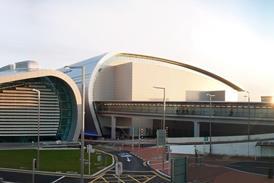The London Borough of Hillingdon and Mayor of London, Ken Livingstone, have agreed to grant planning permission for a new environmentally sensitive passenger terminal at Heathrow.
Subject to completion of a legal agreement, the new terminal, Heathrow East, will not increase the capacity of the airport but will replace Terminals 1 and 2. Phase 1 of the new building could be open as soon as London Olympics 2012.

Heathrow East is part of a £6.2 billion ten year investment programme to transform Heathrow and will set a new standard in environmentally sensitive airport buildings, cutting carbon dioxide emissions by around 40% compared to the current terminal buildings it will replace.
BAA, working with the London Borough of Hillingdon and the Mayor has designed a building that requires less energy; generates decentralised energy through on-site combined cooling heating and power (CCHP); and uses on-site renewable energy such as biomass gasification and photovoltaic solar panels.
Tony Douglas, (pictured) chief executive, BAA Heathrow, said: "By June 2012, most of our passengers will be travelling through terminal facilities that aren’t even open today and we will have either re-built or redeveloped all our other terminals. Heathrow will be a new airport for London."

Mayor of London, Ken Livingstone, said: "We've been able to agree a plan that puts energy efficiency and renewables at the heart of plans for a new Heathrow terminal, and we've secured a commitment to address the energy demand of the airport as a whole.
"The challenges associated with climate change will define how our city develops in the coming decades and, as the gateway between our city and the world, it is right that Heathrow Airport leads the way in meeting those challenges."
Heathrow East will be the first major development in London to use biomass gasification. This process generates a renewable gas from waste wood and sustainable forests that can then be used to fuel a combined heat and power plant serving the terminal.
Adopting this technology supports one of the key priorities from the Mayor’s Climate Change Action Plan by seeking to demonstrate the potential for renewable energy from biomass. BAA will share the results of the technology with the Mayor’s environment team and the London Climate Change Agency to assess its potential use in future developments.
| Heathrow’s transformation timeline: |
|---|
| 2007 – Completion of the first phase of a major upgrade of Terminal 3, with the re-design and modernisation of the departures forecourts. This work significantly improves check-in facilities, pedestrian routes, and traffic congestion. A £1 billion upgrade of the entire terminal is planned over the next ten years. 2008 – Terminal 5 opens. The new terminal will provide world-class facilities and will be the first major new terminal at Heathrow for over 20 years. Extensions to the Piccadilly Line and the Heathrow Express also open. Airlines are relocated by alliance partner to provide quicker transfers for passengers. Terminal 2 demolition starts. Terminal 1 is refurbished to improve service, until Heathrow East is fully open, including new check-in area, baggage reclaim and arrivals concourse. 2009 – Refurbishment of Terminal 4 complete. This includes increasing the amount of natural light entering the building; improving check-in and baggage facilities; and improving departure lounges. 2010 – Terminal 5’s second satellite building opens, linked to the other Terminal 5 buildings by an underground transit system. 2012 – Phase 1 of Heathrow East opens in time for the Olympics in 2012. Most passengers will be travelling through terminals that weren’t open in 2007. All existing terminals will have been refurbished.
|
Source: FlightGlobal.com























